There was no standard way to take a golf trip during COVID, which is why many golfers tend to get overwhelmed even thinking about planning one. Here’s where we come in. Pack the car and follow our lead.
There’s so much to like about a driving golf holiday. With it comes a freedom to set – and tweak – a schedule that’s all your own and not be dictated to by a set flight time. Plus, you get to avoid airport chaos and stop to take in those unexpected ‘finds’ along the way. Imagine stumbling upon a genuine hidden-gem course that you didn’t know about – and Australia is home to plenty of those – and feeling like you didn’t have time to play it? Travelling by road, the pace is yours to set and yours alone.
Every state offers compelling road-trip options for golfers with an itch to drive. So, no matter where you live, grab your clubs, get behind the wheel and go.
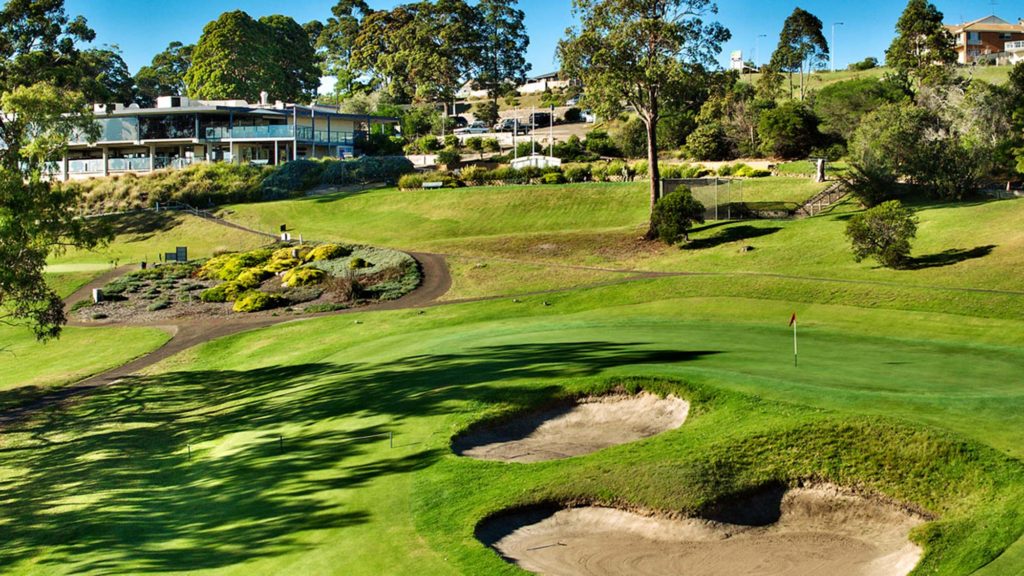
NEW SOUTH WALES
The quest for many people in our most populous state is to get out of the sprawling, heaving mass of humanity that is Sydney. The great news is: there’s terrific golf to be found north, south and west of the city.
One port of call on the road to the north of the city is The Springs, tucked away at Peats Ridge on the inland portion of the Central Coast region. With 18 holes traversing a ridge with views of Dharug National Park, the Al Howard and Graham Papworth-designed Springs course is as scenic as it is pleasant. The course is no pushover, but equally it won’t destroy the confidence. There are places to let loose with the driver and other holes where precision is important. Throw in the welcoming off-course facilities and it’s an ideal place to start any northern sojourn.
Venturing further north and the Hunter Valley and Port Stephens regions beckon. No Hunter golf trip should omit the duo of The Vintage and Cypress Lakes, which are separated by only a few kilometres. Both can now claim to be PGA Tour of Australasia venues after Cypress Lakes staged the inaugural TPS Hunter Valley tournament in March, while The Vintage is a past New South Wales Open venue.
Cypress Lakes was second onto the tournament scene but first to appear in the Hunter. Now 30 years old, the emergence of the Steve Smyers design added golf to the array of activities on offer within the noted wine region. And it is very much within the Hunter wine region, so much so that your tee shot at the second hole needs to carry the corner of a vineyard in order to find the fairway. Recent bunker renovation work and an overall heightened attention towards the condition of the golf course has seen Cypress Lakes reach an all-time high on the appearance and playability fronts.
The Vintage, meanwhile, is closing in on 20 years of operation and likewise offers plenty of clues that you’re in wine country. The rippling and rolling par-5 seventh hole has the Bimbadgen Estate vineyard as its companion along the entire left side of the fairway. Many an errant shot there has wound up among the grapes, turning birdie expeditions into hurried stray-ball hunts. The rest of the course remains as popular and demanding as ever. From the day it opened, the Greg Norman/Bob Harrison design has tested golfers of all levels, as the golf course asks questions of your ability from the outset. There are moments of exhilaration throughout and times when daring strategies can be invoked, but anyone matching their handicap has managed a serious feat. Together with Cypress Lakes, they make one of golf’s great double acts.
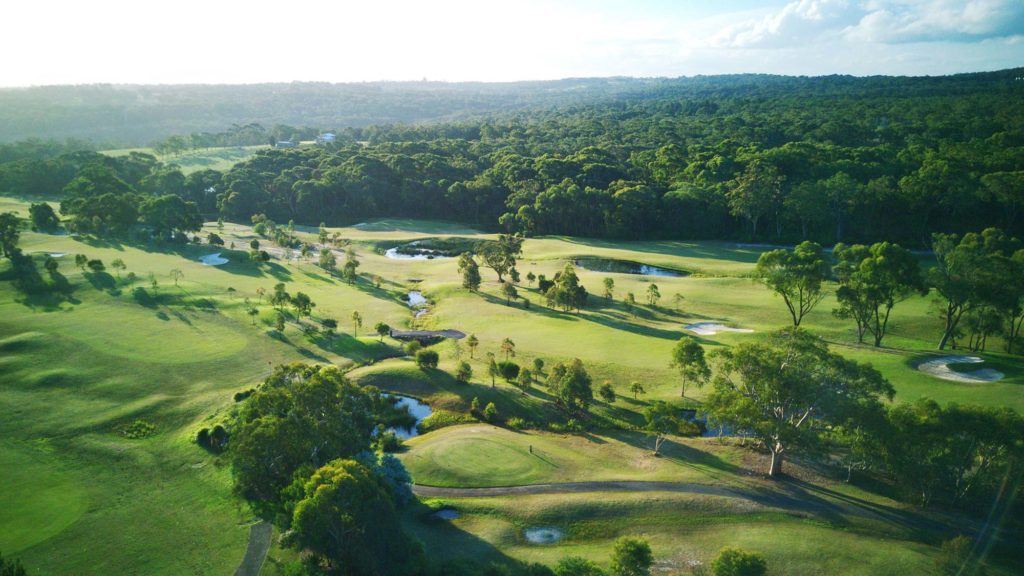
Travelling further north, although not far away, is Pacific Dunes at Medowie in Port Stephens. Here is another golf course ready to leave you with your hands full. A splendid blend of two very distinct nines – a heavily wooded front side and a water-laden inward journey – the layout is testing throughout. Accuracy is paramount, but even the little holes can catch you off guard at Pacific Dunes. Take the 10th, for instance. Modest for length at 288 metres from even the back tee, a large pond lines the left side of the fairway and green, which makes even a lay-up and pitch a moment not to grow complacent. And if you’re trying to drive the green? You’d better hit a 9-out-of-10 shot at worst.
Like its Hunter counterparts, Pacific Dunes is simply a pleasant place to play golf. The course features an adjoining residential precinct, but it is far from intrusive, so you’re left to concentrate on the round amid the flora, fauna and agua, all of which are omnipresent.
One must-make stop between Newcastle and the Queensland border is Bonville, another esteemed resort course that turns 30 this year. No other top-tier course in Australia occupies the same latitude as Bonville, which sits in a part of coastal NSW that often can’t decide if it is rural or tropical. Once an old plantation forest for paper milling, Bonville mixes scenic splendour, solitude and smart design in one of the country’s most popular golf destinations. The layout feels almost like 18 separate holes as the magnificent, fulsome treelines give privacy to most fairways. Famously, there’s even a couple of lengthy cart rides between holes.
Bonville is known for its majestic beauty, but in the past the towering, flooded gums have presented a blessing and a curse for the course. The huge trees give the place its unique calling card, but the same attributes have also made turf maintenance challenging, while the region’s heavy rainfalls have on occasion wreaked havoc on the bunkers. Over time, however, Bonville’s management has worked through the issues, learnt from them and made the changes necessary to present the layout in peak condition year-round. The course feels part tropical, part forest but completely secluded, which is part of its enduring appeal.
Turning in the other direction and heading south of Sydney, Worrigee Links at Nowra is part of the vastly underrated golf scene of the Shoalhaven region. Originally designed by Ken McKay and opening in 2005, the course is largely flat, open and with minimal trees – befitting a course with “links” in its name. However, the course is in for an exciting refresh. Golf-course architect Ben Davey unveiled a masterplan in February that will raise the layout’s appeal as well as add 250 metres and lift the par from 70 to 71. By better utilising the site’s existing wetlands and enhancing its natural features, Davey’s plan is to bring out the ‘wow’ factor in Worrigee. The first step is to build an extra hole, which is likely to happen later this year and will ultimately become part of the final layout. That will give the club the flexibility to work on the existing holes one at a time while keeping 18 holes in play. The current timeline has most of the work being completed by the club’s 20th anniversary in 2025.
At the lower end of the South Coast, Tura Beach Country Club is the pick of a collection of courses near the town of Merimbula. Boasting a Peter Thomson-designed golf course and extensive views of the Pacific Ocean, the Tura Beach layout is also full of variety. Laid out across an undulating piece of land, the golf course takes in several dramatic changes in elevation while also visiting a flatter region early on the front nine that’s so close to the beach, you’re bound to experience either the sound of crashing waves, a little salt spray on your face or both. A combination of the setting and Thomson’s design nous keeps golfers on their toes as they try to decipher the layout.
If you’ve had your fill of coastal golf, NSW also owns plenty of variation inland, as evidenced by two golf courses within the town of Orange. Duntryleague is the best-known course in Orange, memorable for the 150-year-old mansion presiding over the course (and yes, you can book to stay there). On the course, the couch fairways and bentgrass greens add considerably to a layout lined by more than 100 different species of trees. While the golf course gives you a taste of Duntryleague, staying in the mansion lets you soak up the total experience as you revel in the history of the impressive gold rush-inspired era, dine in the award-winning restaurant or enjoy a bottle of local wine and a cheese platter on the deck overlooking the gardens.
Around the corner, Wentworth Golf Club has long been known as the ‘friendly club’, a reputation that harks back to its formation in 1965 when the locals began to turn a paddock into a golf course by removing trees, blasting out stumps and carrying buckets to pick up rocks from the fairway. It was all in the name of turning the area into an 18-hole, grass-green course with 22 bunkers, three dams and a small pine forest. In May 2019, a fire tore through the Wentworth clubhouse. Plans have been approved for a new structure and work will begin in the coming months. The new clubhouse will feature bars, dining areas, function rooms, golf simulators, an indoor kids’ play area and floor-to-ceiling glass offering fantastic views of the course.
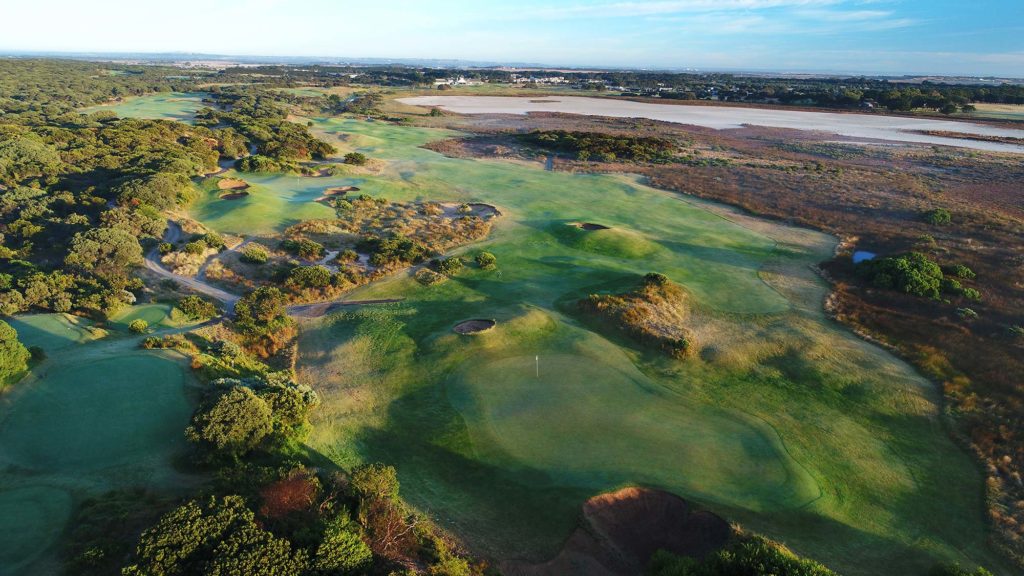
VICTORIA
The Garden State remains the throbbing heart of golf in this country, while the blood coursing through the veins and arteries is the Murray River. Yet as established and popular as the Murray’s healthy collection of golf courses was for so many years, there remained an opening for a brash newcomer.
That upstart came in the form of Black Bull Golf Course, which opened in 2015 and has gradually expanded from being merely a great golf course on the shores of Lake Mulwala, to also include the thriving Silverwoods residential estate and, as of November 2020, a luxurious place to stay with the opening of the Sebel Yarrawonga. The pillars of ‘Live, Stay, Play’ have carried Black Bull, the Sebel, Silverwoods and the entire Murray region to a whole new echelon as a place to holiday or live.
The whole region’s popularity cannot be overstated. You’re squarely in a rural setting yet you’re right beside the water with the lake as a backdrop. And it’s a place that’s easy to reach from Melbourne, Canberra and Sydney, something more and more golfers are discovering.
“My view on it is: people aren’t going to be travelling overseas for some time and… rather than doing one or two big trips a year overseas, I think they’re going to be doing more shorter, sharper stays,” says James McCully, Black Bull’s director of golf.
“We have seen a huge amount of new faces. I would say the past 18-24 months, we’ve seen upwards of probably 50 percent of people who have never been to Yarrawonga before. It’s definitely had a large exposure to new clientele, new faces, and I think that’s a derivative of people only being able to travel internally rather than overseas.”
The total offering at Black Bull is now complete, with the ability for guests to play and stay as well as soak up the on-site bonuses of the accommodation, spa, restaurants and, of course, golf course. A typical day might begin with a morning 18 holes followed by a sports or remedial massage in the afternoon and end with a world-class meal before retiring to a hotel room or apartment.
Across the border into NSW but still only a 10-minute drive away is the largest golf complex on the Murray, the 45-hole extravaganza that is Yarrawonga Mulwala Golf Club. In recent years the club has strengthened its non-golf offerings, of which there are plenty. Yarrawonga can validly call itself a complete destination, so much so that if there were no other golf courses nearby golfers would be unlikely to need to leave. Aside from the abundant golf are various styles of accommodation, bistros/restaurants, tennis, bowls and croquet, a health and fitness centre and even a cinema.
The fifth hole on the Murray course is the only hole along the entire river where the great watercourse is legitimately in play. It’s a seminal moment in any Murray River golf journey. The chance to strike a ball directly alongside the mighty ‘stream’ is inspiring enough, but the added lure is that the fifth is a reachable par 5. Length is not the primary defence of this hole, rather a split-level fairway that cants towards the water and a huge river gum smack-bang in front of the green – plus a deep greenside bunker – are the main obstacles.
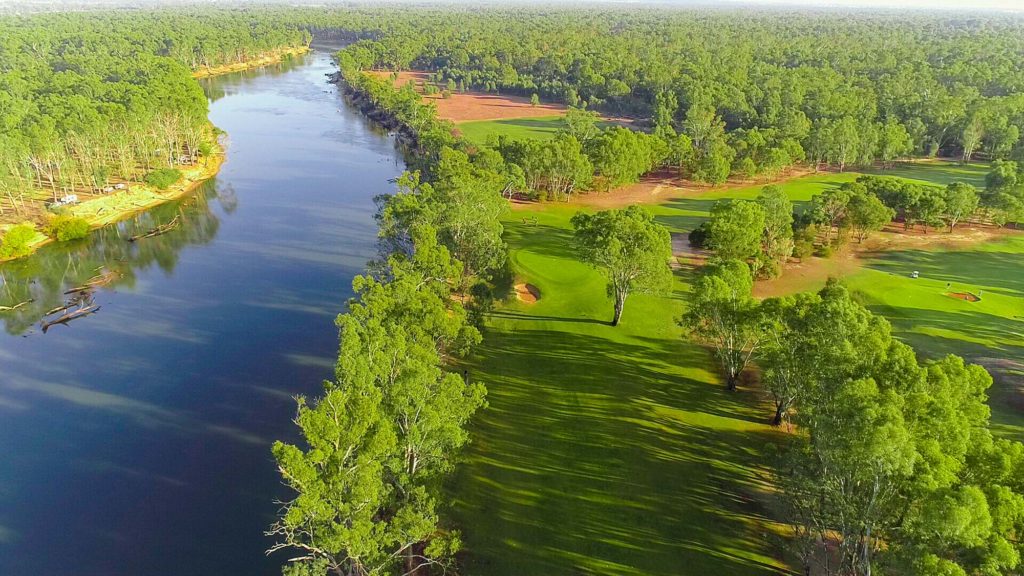
The Murray course gets the nod as the superior layout, but the Lake offers more variety within its 18. It climbs up and down more than the almost dead-flat Murray course, with several sharp elevation changes at key points of the Lake course. Water is in play throughout but not in the abundance the name suggests, rather at selected and strategic points during the round.
Nearing the western limits of the region, Murray Downs Golf & Country Club is the course credited for so long as the best along the river. The Swan Hill region might be a trek to reach, but Murray Downs makes it worth the effort. Built next to the spectacular surrounding Mallee plains, the arid scrubland borders several holes, a vivid reminder of the transformation required when brothers Ted and Geoff Parslow designed the course. The layout is as beautiful as it is challenging, with backdrops of river gums, artfully formed lakes and several tricky holes. Most notable is the 194-metre par-3 fifth, which features a daunting carry over a lake that also works its way along the right side of the deep green, while bunkers guard the left side.
Murray Downs’ resort accommodation spans 50 individually air-conditioned and well-appointed family rooms and two-bedroom units. And as is the case with many of the on-course accommodation along the river, the golf course is only a hundred or so metres away, meaning you can be on the tee at first light or warm and dry moments after wrapping things up at the 18th (or 19th). And if you’ve played this far along the Murray, chances are you’ll be in high need of a comfortable place to rest a golf-weary body.
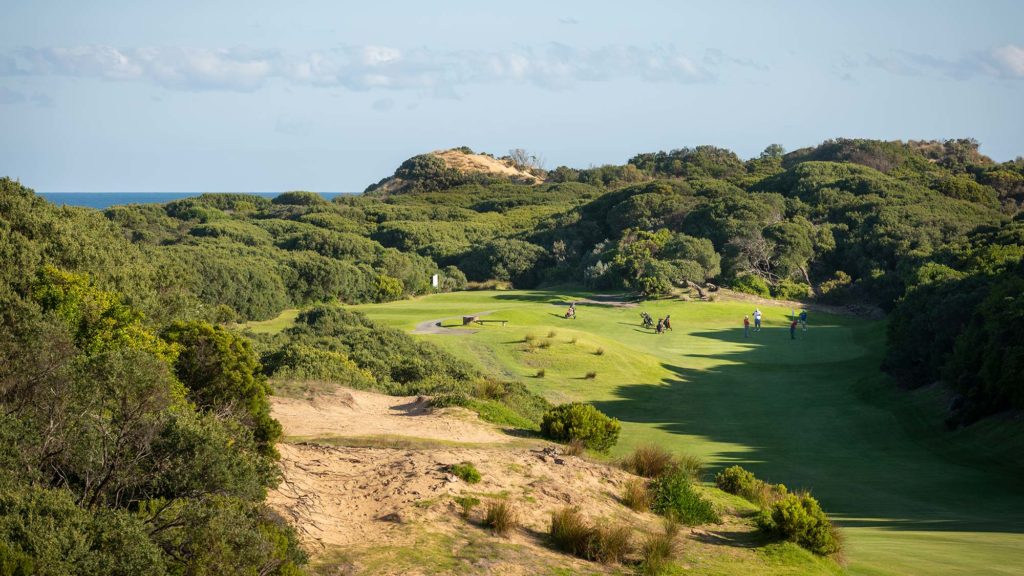
Wending a path back to Melbourne, and there’s a sneaky-good layout on the eastern edge of the city that’s enjoying new life. In March, Waterford Valley Golf Course joined the Golf Services Management portfolio, the seventh course to come under the GSM umbrella, six of them in Victoria. Designed by Phil Ryan from Pacific Coast Design, the course has a corporate-golf market in mind, although at 6,545 metres from the back markers, it will stretch golfers of any level even if there is ample space to manoeuvre from tee to green. Lakes and wetlands are a feature of the layout, as are the large G2 bentgrass greens.
Nudging down onto the fabled Mornington Peninsula, and Portsea Golf Club remains one of the most treasured layouts in the golf-rich region. Portsea is a classic case of good things coming in small packages. Located amid the flashy, brawny layouts nearby is this old-school, 5,747-metre gem that even modern technology cannot dilute. Firm and bouncy with rugged, craggy bunkers, Portsea is as fun as it is charming.
About the only change to the layout in recent memory is a re-sequencing of the holes when a new clubhouse and hotel was constructed in a central part of the property in 2013, and a shortening of what is now the first hole from a par 5 to a par 4. Given the new clubhouse’s location, it’s a practical routing and realistically the only option possible in order to achieve two returning loops of nine holes. However, whether by coincidence or some manner of cosmic forethought all those decades ago, the new sequence strengthens the overall layout by placing the most strategic holes at key points in the round. What are now the 17th and 18th holes, for instance, are two strong par-4s that previously sat innocuously in the middle of the front nine. The death-or-glory short par-4 that is now the 15th falls at a far more preferable part of the round than it did as the old second hole. Likewise, the back nine begins with another of Portsea’s wonderful short two-shotters that works as a potential kickstart to the inward half.

One of the delights of moving between Victoria’s two best golf regions is the ability to travel via the ferry linking Sorrento on the Mornington Peninsula and Queenscliff on the Bellarine Peninsula. Rather than make the hours-long drive right around Port Phillip Bay, sailing across it – with your car – makes much more sense and is way more fun. Whether before or after your crossing, Thirteenth Beach Golf Links must be on your agenda.
For many years the Bellarine Peninsula sat in the shadow of its cross-bay sister peninsula when it came to golf. However, the emergence in 2001 of the first course at Thirteenth Beach drew golfers’ attention to the south-western corner of the bay as the golf offerings on the Bellarine began to flourish. Tony Cashmore’s Beach course was an instant hit, adding a second high-quality golf venue to accompany the long-standing Barwon Heads course next door. Cashmore used distinct pockets within the property to create loops that are reconfigured for the Vic Opens held there. These loops give the layout subtly different settings while keeping the entire 18 seamless. Within the course are four exceptional par 3s, the most commendable being the tiny 16th, which teases and tantalises for its 113 metres. First hosting the Vic Open in 2013 shone the spotlight on Thirteenth Beach, but keen golfers knew how good it was from the beginning.
The second layout had a lot to live up to when the Creek course opened three years after the highly accoladed Beach course, yet rather than try to emulate it, the Creek instead sought to carve its own identity. While the same designer was called in, this time Cashmore worked in partnership with six-time Major winner Nick Faldo – the duo created a complementary rather than copycat layout. The Creek course doesn’t have the seaside dunes and blowout bunkers of the Beach, but it does have spacious fairways, a little water, clever bunkering and requires a different strategy. And now with a new par-3 course, Thirteenth Beach has all bases covered.
When you tour the Bellarine, it’s only natural to venture a little further and take the Great Ocean Road to Warrnambool and Port Fairy. Both towns feature exquisite seaside golf courses, with Marc Leishman’s hometown of Warrnambool the first you’ll arrive at travelling from the east. It’s a course where plenty of recent activity has improved a layout that was always blessed with appealing natural features. The part of the course most golfers remember, however, is the sequence of holes known as ‘Shipwreck Bend’. It is indeed a place where good scores can come to grief. Comprising three par 4s – the fourth, fifth and sixth holes – each is tight, each is riddled with potential peril in the form of ball-swallowing scrub but each one is brilliant. Just try to navigate a cautious passage through the danger.

QUEENSLAND
The golf courses of south-east Queensland could really use some TLC in the form of golfer patronage this autumn and winter. Another round of devastating floods has upended a region packed with popular courses and travel destinations. Principal among them is the Gold Coast, with its renowned glitz and glamour – qualities that spill onto its golf courses.
Nowhere is more glamourous than Sanctuary Cove, which offers a pair of Top 100-ranked layouts on the northern end of the coast. The late, great Arnold Palmer left an impression on our country in many ways, mostly notably through his 1966 Australian Open victory. Yet the prolific designer penned only one course here: the Pines at Sanctuary Cove, which was created in concert with Ed Seay in the late 1980s. For many years regarded as one of the toughest – if not the toughest – course in the land, the Pines paired length with tight fairways and a plethora of vast water hazards. In any kind of wind, it can be brutal. Recent renovations have refreshed the mighty layout without compromising its hallmark of towering pines and superb conditioning. Regardless of the tees chosen and the ability of the golfer, the exacting nature of the layout lives on.
For many years the substantially lesser option at Sanctuary Cove, the Palms course is the ugly duckling of Gold Coast golf that blossomed into a beautiful swan. The original Fred Bolton-designed course was good; a solid companion to the more extravagant Pines. Then in 2011 Ross Watson stepped in to reinvigorate the layout and bring the two up to level terms. Mission: accomplished. Nowadays, public golfers don’t feel like they’re coming off second best when they are restricted to the Palms, which is a short but well-bunkered par-70 layout that’s seemingly always buffeted by a considerable breeze.
Right across the road is another icon of Gold Coast golf. The explosion of resort courses in the area reached its crescendo when Links Hope Island opened in 1993. At a time when Japanese investment in golf here was at a frenzied pace, a truly elite course was yet to materialise from the influx of new builds. Among the public offerings, Hope Island stood tallest with Peter Thomson, Mike Wolveridge and Ross Perrett penning their best work as a trio to give the Sunshine State a little piece of British golf in a decidedly un-British environment. Pot bunkers – predictably – rule the terrain, but this time alongside the more Queensland-style hazards golfers come to expect of a more sultry location. The two worlds colliding yielded a magnificent blend of design approaches, as Hope Island quickly became a must-play course. Mobs of kangaroos scattered across the property only add to the allure for both interstate and international golfers.
Staying close to the beach is where all the action is on the Gold Coast, but there’s still plenty to see and do further inland. Kooralbyn Valley is home to a course that’s lived a curious and chequered life since opening in 1979 and staging the Queensland Open a mere two years later. The Desmond Muirhead-designed layout captivated golfers for years but slipped slowly into the background as more courses emerged in a coastal cluster. Later, it slid into disrepair and the course closed between 2008 and 2016 before Peter Huang, founder of the Yong Real Estate group, purchased and re-opened the course and set about re-energising both it and the resort in a multi-million-dollar makeover. Every green was rebuilt, the bunkers were reshaped and refurbished with pure white sand and a new irrigation system installed. With a drawing power from Brisbane, the Gold Coast and beyond, Kooralbyn Valley is back in the frame.
From the Gold Coast, the Sunshine Coast beckons and yet another collection of captivating courses. They’re well-known, they’re endlessly fun and popular, challenging, beautiful and they’re in a prominent holiday location. What’s not to like?
However, if you feel as though you’ve sampled all the top courses on the Sunshine Coast, there might be one that you haven’t played. Peregian Golf Course and driving range is one of the best golf facilities in the region. Located just seven minutes north of Coolum and 12 minutes south of Noosa, Peregian is a premium parkland-style course that’s open to the public every day of the week. The layout is challenging to golfers of all abilities and provides a variety of strategic options. Players need to plot their rounds, potentially taking on some of the hazards and steering clear of others. Peregian’s operator, GSM Golf, is particularly proud at present with ambassador Lucas Herbert breaking through to win last October’s Bermuda Championship on the PGA Tour, aided by his locally based swing coach Dom Azzopardi.
Perhaps you might be seeking a more competitive environment for your stay. If so, the Sunshine Coast Classic will take place not once but twice in 2022. The decision to run two tournaments was made off the back of the success of previous stagings, which attracted players from New Zealand, Victoria, NSW and elsewhere in Queensland.
With one beginning on June 13 and the other on October 10, players are already registering for the 72-hole tournaments played at four of the Sunshine Coast’s finest courses: Maroochy River, Noosa Springs, Peregian and Twin Waters. The twin tournaments are open to all players with a Golf Australia handicap with all players and partners invited to attend the sit-down presentation event after the final day’s play at Noosa Springs.
Each tournament is an individual Stableford competition, with daily prizes for men and women in A and B grades, four approach-shot prizes each day, as well as prizes for the 72-hole event. The entry fee, which includes four days of golf with carts, daily lunches, welcome and presentation functions plus a gift package, is available for $695 per player with discounted accommodation and transport deals available through the tournament’s partners. For more information and to book your place, visit golfsunshinecoast.com.au/2022-sunshine-coast-classic/
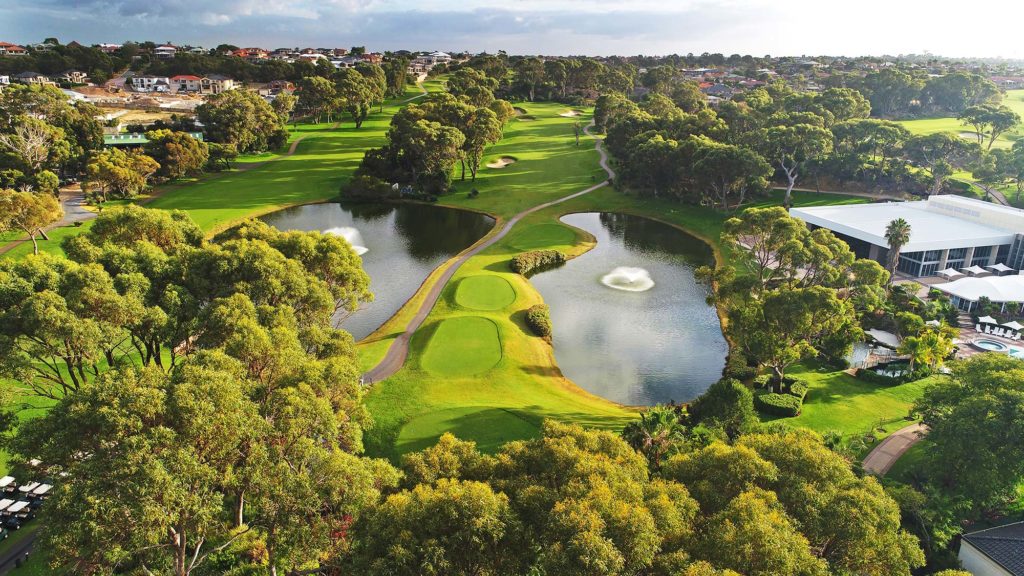
WESTERN AUSTRALIA
The west is open again! After 697 days, West Australian premier Mark McGowan is now allowing those from ‘over east’ back into our geographically largest state. If you’ve never been to WA, or it’s been a while, it should be on your golf radar. There’s plenty of good golf on offer in the stretch of coastline south of the city, but if the journey to Perth was enough travel for you, there’s a one-stop-shop within the suburbs.
Man first walked on the moon in 1969; for golfers it took another 16 years. That was when Robert Trent Jones Jnr converted a disused limestone quarry in what was then Perth’s outer north into one of the most extraordinary golf environments in Australia. The Quarry and Dune nines at Joondalup Resort (the adjoining Lake nine was added a few years later) showed golfers an entirely new landscape, in places appearing not unlike that of our planet’s lunar body.
There are holes at Joondalup that can simply never be replicated. The eye-catching par-3 third hole on the Quarry nine plays across a gaping quarry that also needs to be negotiated on approach shots to the fifth green. In between, at the par-5 fourth, an enormous bunker reinforced by a towering rock wall hugs the inside of the uphill dogleg right. On the Dune nine, remnants of the site’s former use line several holes, while throughout the complex are menacing, multi-terraced greens possessing an infinite capacity to bewilder. It’s a look that superficially can feel thoroughly un-Australian… until a mob of kangaroos hops past. The adjoining resort will also give you a place to rest between rounds if playing all 27 holes in one day proves to be too much.
SOUTH AUSTRALIA
Like Perth, Adelaide is home to terrific collection of golf courses but also some worth venturing wide of the city for. A pair of options south of the city merits the journey.
The design trio of Jack Newton, Graeme Grant and the late John Spencer craftily wrapped the 18 holes at Links Lady Bay across a mildly furrowed parcel of land overlooking the sea but bisected by a spur. Most of the holes sit on the seaside portion of the site, although several holes on the back nine meander around the other side and create a neat point of difference. Notable for Grant’s ambitious yet artistic green complexes, Lady Bay wears a different dress depending on the elements. It is a different golf course when firm and fast versus lush or when the winds switch with the seasons.
A little further south, the club formerly known as Fleurieu but now called Mount Compass is a course on the rise. Design-wise, the body of work is a combination of Neil Crafter and his late father Brian. The pair penned the front nine in collaboration with Neil devising the back nine on his own. These days, Neil is in constant consultation with the club as it strives to maximise its considerable potential. The layout gets right the crucial mix of being a perpetual challenge for expert players yet entirely playable for novices. Mount Compass is a tidy, links-like layout with a distinct Sandbelt approach to much of its bunkering, where heather, ferns and other attractive foliage hems the non-fairway/green side of the hazards.

TASMANIA
Because of its small size, Tasmania is not often regarded as a driving holiday destination although plenty do so. Whether by flying first and hiring a car or taking your own vehicle aboard the Spirit of Tasmania and docking in Devonport, there are plenty of roads to cover on our island state and oodles of golf courses to see and play. One of the best is also the only Tasmanian course to stage the Australian Open.
Last year marked 50 years since Royal Hobart hosted the lone Open held south of Bass Strait, and recent years have seen slow but steady improvements to the venerable course. The club tasked course architect Richard Chamberlain with redesigning its seventh hole, partly to alleviate safety issues with balls straying onto the wrong hole while playing the sixth and seventh but also as a straight-out redesign. The short, often driveable par 4 opened for play in October 2020 and adds a new element to a golf course that remains highly interesting for one so flat. The activity didn’t stop there, however, as a new driving range and practice facilities soon greeted members. Royal Hobart also removed a stack of trees of various species to open the playing corridors and improve the health of the turf.
With more activity on the horizon – the nearby Seven Mile Beach and Arm End courses are both set to open in late 2023 or 2024 – the pulling power of our southern capital has never felt stronger.
